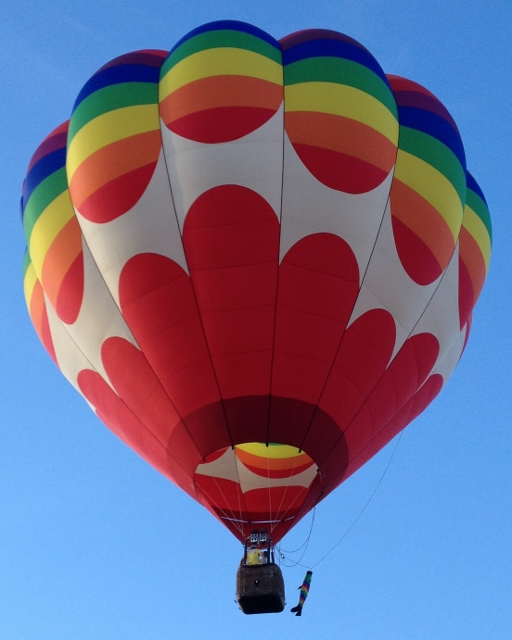 |
"Earning your wings"
|
So you want to be a pilot... the first question you must ask yourself is 'Why'? Are you looking for a fun hobby to share with family and friends? Are you thrill seeker dreaming about the glamorous life of a full time balloonist? If the latter is your desire you may want to re-think things. If done right, the adrenaline rushes are few and far between, and though it is possible under some circumstances and in some areas to be able to make a full time job out of ballooning, it is difficult to do and often not what most would consider glamorous. Generally speaking there are 5 types of balloon pilots. The sport and pleasure pilot, the competition pilot, the ride operator, the corporate pilot, and the shape pilot. Each type of pilot sometimes delves into the other aspects of ballooning, but their main focus is usually in one specific type of flying. In a few areas there are flight schools where a balloon pilot certificate can be earned in a couple of weeks time, but most pilots learn from instructors in their local area over an extended period, sometimes months, sometimes years. For most, the local instructor route is preferred as it offers varying opportunities for different situations and the chance to spend time on the ground crews of other pilots, learning many different aspects of ballooning beyond those which are taught at a 'crash course'. Becoming a pilot requires a substantial amount of time and money. New, a standard balloon system will cost upwards of $30,000 but just like cars, there are a lot of options available in the used market for a significantly lower price. Beyond the balloon itself there are other things that need to be considered, a chase vehicle and / or trailer, insurance, annual inspections and maintenance, refreshments for your crew... it can all add up very quickly. Training, testing, and recurrent training can also be very time consuming, but if you can overcome all of the obstacles becoming a balloon pilot can be a very rewarding experience. The first step is becoming a student pilot. The student pilot's time is spent learning the aspects involved with not only the balloon, but with the rules and regulations set forth by the Federal Aviation Administration. To move beyond the student certificate and earn your private pilot certificate (there is actually no such thing as a pilot's license), you must have had the required flight and ground training from your instructor, completed some specific flight tasks including a solo flight, and pass a written test from the FAA. Once those steps are completed your instructor will sign you off for your practical test which consists of an oral test as well as a flight test administered by a designee of the FAA. Your private certificate allows you to fly in any capacity that is not deemed in any way to be a commercial venture. Essentially that means you cannot fly for hire or compensation. A private pilot can be a sport pilot or a competition pilot and CAN fly a special shape or a larger ride balloon, but there cannot be any compensation involved. In the airplane world, most of the small single engine airplanes at your local airport are operated by private pilots. To be able to be compensated for flying, you must have a commercial pilot certificate which requires additional training and flight requirements as well as another set of written and practical tests beyond those of the private pilot. At that time you can do whatever type of flying you choose to do. A balloon pilot's commercial certificate also comes with flight instructor privileges, so you can also teach others to fly. In the airplane world, the pilot of your commuter planes and airliners are commercial pilots. For airplanes an additional rating is required to become a flight instructor. |
|
When I obtained my commercial pilot certificate I was approached by my first students, a young couple who already held their commercial pilot certificates for airplanes. Having already had those certificates, they will be able to bypass some of the earlier requirements and earn their commercial balloon rating after some flight training and a practical test. I was honored to be chosen by them, both far more accomplished pilots than myself, and having them as my first students has been very good for me as they have been teaching me just as much about instructing as I am teaching them about flying balloons. The added benefit of them already having a vast knowledge of the rules, regulations, airspace system, and weather has also made things significantly easier for me. I couldn't ask for a better set of first students, and I thank them for helping me branch into the world of instruction.
|
|
|
 |
|
We are members of the Great Plains Balloon Club, a group of ballooning enthusiasts who share a passion for the sport and encourage anyone interested in ballooning to follow their dreams and keep the true spirit of ballooning alive and well. We also believe that maintaining an active membership in the Balloon Federation of America, a unified voice representing balloonists across the U.S., is a vital step to keep ballooning as an activity that can be experienced by people from all walks of life. |
|
A special "Thank You" goes out to all of the landowners across the country who allow balloonists to launch and land on their property. If it wasn't for your hospitality none of this would be possible. We are at the mercy of the winds and consider ourselves lucky to meet so many wonderful people when we drop in uninvited. We hope you have had a pleasant experience and have some photos and special stories of your own to share with your friends and families. |